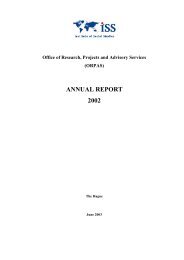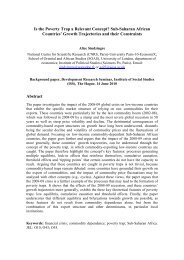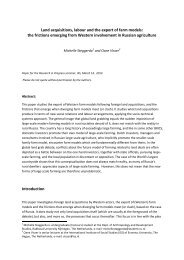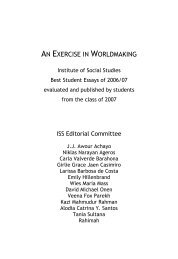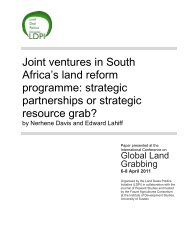AN EXERCISE IN WORLDMAKING 2009 - ISS
AN EXERCISE IN WORLDMAKING 2009 - ISS
AN EXERCISE IN WORLDMAKING 2009 - ISS
You also want an ePaper? Increase the reach of your titles
YUMPU automatically turns print PDFs into web optimized ePapers that Google loves.
16 What’s Yours is Mine 191<br />
this voyage; therefore shifting that Helper to the category of ‘obstacles’:<br />
people pretending to know the Victim.<br />
The second nameless Magic Helper appears, who ‘got wind of the<br />
search,’ as though nature is carrying the goal through elemental forces.<br />
This Helper is obliging and mentions childhood history with the Victim<br />
as well as her present location. He brings her, defying obstacles not only<br />
temporal (‘six-hour drive and three-hour hike’) but deadly (‘across a border<br />
that swallows lives’). Despite that, she arrives after three days with<br />
children and, like a lover’s reunion, Hero and Victim meet: ‘When<br />
McCurry saw her walk into the room, he thought to himself: This is her.’<br />
And with his certainty, she is ‘found.’<br />
4. Evaluation: Examination of Her Life, Her Body<br />
The ‘finding’ instigates evaluation in many forms: free clauses on the<br />
story from outside (‘it was the strangest feeling’); attributed character<br />
commentary; extra details; suspension of action via paraphrase/repetition;<br />
gesture intensification; and comparisons of what did/did not happen,<br />
or might have been (Johnstone 2001:638).<br />
Villain ‘namelessness’ is first resolved, ‘Names have power, so let us<br />
speak of hers: Sharbat Gula.’ No longer anonymous, yet her name,<br />
probably unheard before by ‘typical’ Western readers, will not resonate,<br />
establish connection or meaning. Gula will effectively remain ‘other.’ To<br />
embed the unusual, she is identified as Pashtun, described as ‘the most<br />
warlike of Afghan tribes,’ reinforcing ethnicity-driven barbarism and racist<br />
perspectives Western militarized discourse often attributes to Third-<br />
World conflict. This is further legitimized by presenting supposedly<br />
widely-known (essentializing) facts, ‘it is said of the Pashtun that they are<br />
only at peace when they are at war.’ Here the entire ethnicity is not only<br />
attributed to being inherently violent, but enjoying it as well. This separates<br />
them from the intended audience of ‘good, socially proper and stable<br />
persons’. Gula is identified within this violent category: ‘her eyes -<br />
then and now - burn with ferocity,’ as though both as adult Pashtun and<br />
as child, she embodied natural aptitudes for violence.<br />
Damaging attributions continue in discussions about the uncertainty<br />
of her age. ‘Stories shift like sand in a place where no records exist. No<br />
one, not even she, knows for sure.’ The metaphor evokes stereotypical<br />
‘Arabian night’ imagery, and bestows importance to Western recordkeeping<br />
and science. The timelessness of Afghanistan is reminiscent of




